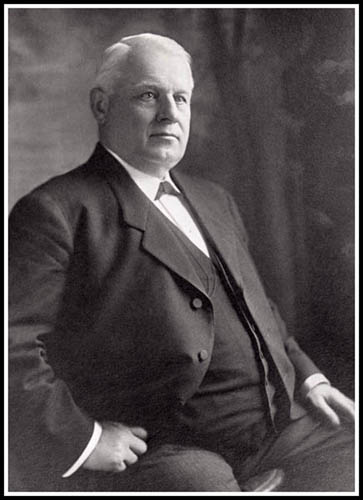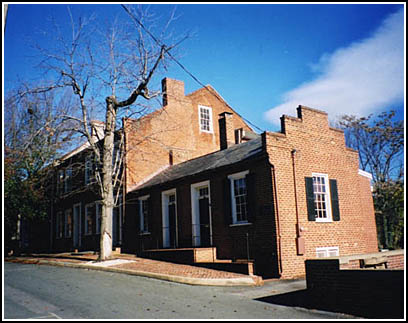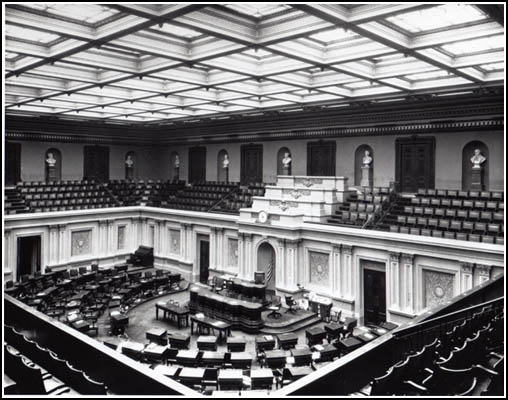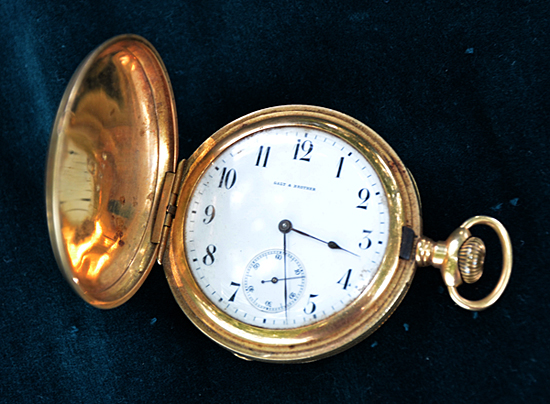

  |
|

|
Name: Senator Thomas Staples Martin Date: ca. 1910 Image Number: TSM003 One Virginian who has unfortunately fallen through the historical cracks is Senator Thomas Staples Martin, a Scottsville-born, twenty-six year Senator, whose career only ended with his death in 1919. Although changing political winds and accusations of corruption blemished his legacy, Martin proved to be a prominent political figure on the national scene, ultimately becoming the figurehead of the conservative wing of the Democratic Party during the early part of the twentieth century. Despite their political differences, Martin worked harmoniously alongside Progressive Democratic President Woodrow Wilson during World War I to protect the Commonwealth and nation. Thomas Staples Martin was born July 29, 1847, to John Samuel Martin and his wife, Martha Ann Staples. He was one of eight children. When John Martin left his home in Fluvanna as a young man, he came to work in the store of Thomas Staples, where he met his future wife. The two married on November 3, 1840. John Martin eventually took over the Staples store, acquired a woolen mill, and later became Justice of the Peace. In 1853 the Martin family moved to Fairview, a farm outside of Scottsville. Known as "Tom," Thomas Staples Martin attended the school of Mr. D. Pinckney Powers in Albemarle. When Tom Martin turned sixteen, his father began writing to General F.W. Smith, of the Virginia Military Institute, as, according to the elder Martin, his son was �disposed to a military life or profession, and I desire to give him all the advantages of an education, as seems suited to his disposition.� Martin matriculated into the Corp of Cadets in March of 1864. Less than three months after Martin�s arrival, the Confederate Army called up the Corp to defend the Shenandoah Valley. This order culminated in the Cadet charge at the Battle of New Market. Although Martin missed this battle due to illness, he later saw some action on the battlefield. In late 1864, the Corp�s campus at Lexington burned, and the school moved to Lynchburg, and then to Richmond, in an attempt to continue training. But when Richmond was evacuated in April 1865, the Institute dissolved and left each cadet to his own destiny. For some this meant joining the Army as a full time soldier, but for many, like Martin, this signaled a time to go home. After the end of the war, Martin�s family decided their son should continue his education at the University of Virginia. In hopes of rebuilding their crumbled country, Martin and classmates began session in Charlottesville in October of 1865. While Martin was a student, enrollment began to climb back up from its low of 46 students in 1863, to 258 in 1865, and 490 in 1866. Martin took classes in several different �schools� in his time at UVA, from languages to history and literature. Unfortunately, however, Martin was once again unable to complete his education because of tragedy. In 1867, Martin�s father passed away suddenly at the family farm, leaving behind a store and mill which required tending. Tom withdrew from UVA and returned to Scottsville in order to serve as the breadwinner for his family, though he would remain closely connected to the University for the rest of his life, later serving a term on the Board of Visitors. Martin took care of his family duties while studying law at night and was admitted to the local bar in 1869. He began practicing law in Scottsville but also worked in the courthouses of Buckingham County, Fluvanna County, and Charlottesville. Over time, Martin developed a reputation for his ability to settle many cases outside of the courtroom and for his expertise in land deeds. Throughout the 1870s and 1880s, Martin established himself as a prominent lawyer, and eventually the Chesapeake and Ohio Railroad appointed him as its local representative counsel. In 1889 Martin became a charter member of the Virginia State Bar Association, serving on its executive committee.  Law offices of Thomas Staples Martin, not far from the
Albemarle County Courthouse in Charlottesville, VA. During this time, Martin also became an influential member of the Democratic Party in Virginia, serving directly under party head John Barbour on the Executive Committee. In 1885, however, he galvanized support for Barbour�s successful Senatorial opponent, John W. Daniel, and consequently gained recognition as a major organizer within the Party. He further proved himself as a political force by helping to secure control of the General Assembly in 1891 for his conservative allies within the Party. Throughout these elections, Martin rarely canvassed to the general public, but instead wrote notes to his friends to persuade them to campaign at local levels while he stayed behind the scenes. Martin recognized the power of political uniformity inaugurated by Barbour and in turn perfected his ability to unite, laying the groundwork for his success in gaining office. In the fall of 1893, Virginia had two U.S. Senate seats to fill: one for the unexpired term of Senator Barbour, who died May 14, 1892; the other for a full term beginning in 1895. Thomas Staples Martin emerged as candidate for the Democratic nomination against former Governor Fitzhugh Lee, both vying for the full term. The race, like other Virginia Senatorial races of the period, would ultimately be decided not by popular vote, but by a caucus of General Assembly Democrats. Governor Lee, nephew of Robert E. Lee, had served as a cavalry officer under J.E.B. Stewart, and was overwhelmingly popular as governor. Martin, on the other hand, though well-recognized within the Party, was virtually unknown to the general public, and most did not consider him a likely candidate for Senator. Hence the public outcry that erupted when on December 7, 1893, Martin emerged victorious over Lee. Over the past several months, Lee had traveled across the state, making speeches and public appearances; by contrast, Martin had campaigned by appealing only to those whose votes counted, the Democratic lawmakers themselves. Lee�s campaign staff watched in disbelief as many who had pledged their support for the former Governor voted for Martin instead. The public clamored for an investigation when they discovered that their representatives had voted for a political unknown. Constituents accused Martin of corruption, claiming that he had used railroad money to intimidate and pressure members to vote for him. An investigation did follow, but after hearing testimony for several days, the committee cleared Martin of any wrongdoing, and the Senate officially elected him at the end of 1893. Before taking office in 1895, in the fall of 1894 Martin accomplished what many at the time considered a greater triumph than his election as U.S. Senator: marriage. Senator-elect Martin had always been known to friends as a shy person, and some might have had their doubts about the accuracy of a June 27 New York Times headline proclaiming, �Senator-elect Martin May Marry.� On October 10, 1894, Martin married Lucy Day of Smithfield, daughter of a local politician and twenty years Martin�s junior. The couple would have two children, Thomas Staples, Jr., and a daughter, Lucy.
Martin had to face the public in order to seek re-nomination in 1905, as the Democrats had set up primaries for the Senatorial Contest. Martin�s opponent was independent Governor Andrew Jackson Montague, one of the champions for the Democratic primary and an �anti-machine� leader. This is the first time Martin actively canvassed and went on a speaking tour across the State, now that he was answerable to the people. As in the previous election, Montague attacked Martin on his undistinguished record as a Senator and his ties to the railroads. On July 6, at King George Court House, Martin made a three hour public appearance in a debate against Montague. Against the thoughts of many, Martin proved himself an able public speaker and strong debater against the governor. Martin won the nomination with 56% of the vote. In 1910 he became a member of the powerful Appropriations Committee, along with his other Committee assignments, several of which he was the senior or second to the senior Democrat. In 1911, prior to the fall election, the Democratic caucus selected Martin as its Minority Leader. In the fall of that year, Martin and friend Claude Swanson faced off against William A. Jones, the main leader of the Progressives, and Carter Glass. Again Martin and his forces succeeded, defeating Jones and Glass two to one in their respective races. In the winter of 1912, Senator Martin left his relatively new home Montesano in Charlottesville as Virginia�s senior member in the Senate and as one of the most powerful men in politics. With the Democratic Party and the political system of Virginia under his control, Martin ran unopposed in 1918.
Woodrow Wilson, known as the �schoolmaster� by many opponents, became President in 1912. Wilson and Martin would evolve from being political rivals to close political allies. Martin opposed Wilson�s nomination for President because of his Progressive tendencies, and his organization tried to undermine the Wilson campaign in the Governor�s home state. When President Wilson came to the White House, he did not meet with any of the conservative wing of the Democratic Party, of which Martin was the figurehead. Wilson�s allies in Congress also applied pressure to its Conservative members, so that in 1913 Martin withdrew himself from seeking reelection as the Minority leader. Senator Martin, however, knew the importance and value of loyalty, and so supported Wilson�s plans in an effort to present a united front for the Democratic Party. In 1915, Martin�s efforts in Congress were stopped completely as his wife�s tuberculosis worsened, from which she had been suffering for several years. The Senator went home to be with Mrs. Martin until she passed away January 7, 1915 in Charlottesville. Out of respect for Senator Martin and the memory of his wife, the Senate set a precedent by passing a formal resolution of sympathy upon hearing of her death. With Mrs. Martin�s passing, Senator Martin devoted himself entirely to his work in Congress the last four years of his life, becoming the Majority Leader in 1917. The United States was on the watch as the whole of Europe engulfed itself in the Great War. In early 1917, Wilson wanted to arm merchant ships to defend themselves from German U-Boats, but filibustering in the Senate was about to kill the bill. Wilson asked Martin for help, in turn Senator Martin introduced the first cloture rule into the Senate. Later, President Wilson sought to have Congress declare war on Germany, but the chair of the Foreign Relations Committee refused. Senator Martin took care of Wilson�s wishes and introduced a resolution in the Senate on April 16, 1917. Wilson was reliant on Martin�s presence in the Senate to get legislation through during the war, and when the peace came, he was counting on Martin to be able to help. Martin, however, left Washington in the spring of 1919 after Congress let out and would be unable to ever help Wilson�s plans for peace.  The U.S. Senate floor in 1919.
Before his death, Senator Martin sat in Seat #58 on this floor from 19 May 1919 to 13 November 1919. Throughout the summer and autumn of 1919 the press constantly kept up with Martin�s conditions in order to inform Virginians about their Senator, now 72 and in failing health. According to the Senator himself, he was still able to perform his duties. In the last letters between Martin and Wilson, Wilson wished Martin a speedy recovery and told how much he needed him back in Congress. In his reply, Martin commended Wilson on his work in Paris and expressed his eagerness to return, stating that if nothing else he would take the train from Charlottesville to Washington, vote, and then return. In November Martin entered the hospital for the last time, passing away November 12, 1919. Senator Swanson, Martin�s long time friend, announced the Senator�s passing in the Senate, and immediately a resolution passed for a party of members to attend Martin�s funeral. However, the next day, prompted by its members, the Senate adjourned so that friends could attend Martin�s large public funeral at the University of Virginia�s chapel. The following spring the Senate memorialized Martin formally. Thomas Staples Martin shared many beliefs with other Southerners of the day, and for Virginians in general, he represented their ideals and needs in the Senate for over twenty-six years. Martin solidified the Democratic Party that Barbour built and that Harry Byrd controlled through the 1960s. He dedicated himself to service, which led his children to write as his epitaph that their father was �faithful to every duty in life.� Martin�s name should be synonymous with all other Virginians who have served their state and country. Thomas Staples Martin: Senator, Leader, Virginian was written by Rob Manoso, a 2007 intern at
Scottsville Museum from the Institute of Public History at the University of Virginia, Charlottesville.
Angela Nemecek, a PhD candidate in the English Department at the University of Virginia, edited Rob's article for publication.  Thomas Staples Martin's gold pocket watch. Courtesy of Thomas Staples Martin, Jr.; Thomas Staples Martin Collection, Scottsville Museum Virginia's Jim Crow Constitution of 1902
by Evelyn Edson, President, Scottsville Museum August 10, 2020 We want to pass along to you information provided by George Coussoulos about Thomas Staples Martin this week. He writes, "I can't help thinking that in mentioning his 'conservative' politics, the article should have made clear this meant doing everything possible to disenfranchise African Americans. Martin's political machine was responsible for the 1902 revised state constitution that formalized Virginia's Jim Crow laws. Especially in today's reawakening to the realities of white privilege, a true reckoning of the past is most important." After the Civil War in 1869, Virginia was required to adopt a new constitution, called the Underwood Constitution after the judge that chaired the convention. It extended voting and office-holding privileges to all adult male citizens. The 15th Amendment to the U.S. Constitution guaranteed these voting rights, and acceptance of this rule was a condition of Virginia's readmission to the Union. During the next several decades, the Black electorate expanded, and a number of Black citizens were elected to public office. By the turn of the century, there was a serious backlash, and Whites were determined to restore their supremacy. The main purpose of the 1902 constitutional convention in Virginia was "the elimination of the negro from the politics of the state." In its final form, Virginia voters were required to pay an annual poll tax and to take a literacy test, that was administered in such a way that Black voters were denied their right. The immediate result was that Black voters and poor Whites were effectively disenfranchised. Virginia was governed for years with a tiny minority of its adult citizens actually voting. This system survived into the 1960's under the Byrd Machine. After 1954, this venerable political organization devoted its energies to "Massive Resistance," the continued segregation of public schools. After the passage of the Civil Rights Act in 1964 and the Voting Rights Act of 1965, Virginia adopted a new constitution mandating universal suffrage. The following obituary for Thomas Staples Martin was published in The New York Times, November 13, 1919: Copyright © 2020 by Scottsville Museum Top Image Located On: Capturing Our Heritage, CD TSM01 |
|
|
|
Museum
Archive
Business
Cemeteries
Church
Events
Floods
For Kids
Homes
Portraits
Postcards
School
Transportation
Civil War WWII Esmont Search Policy |
||||
|
Scottsville Museum · 290 Main Street · Scottsville, Virginia 24590 · 434-286-2247 www.avenue.org/smuseum · info@scottsvillemuseum.com Copyright © 2020 by Scottsville Museum |
||||